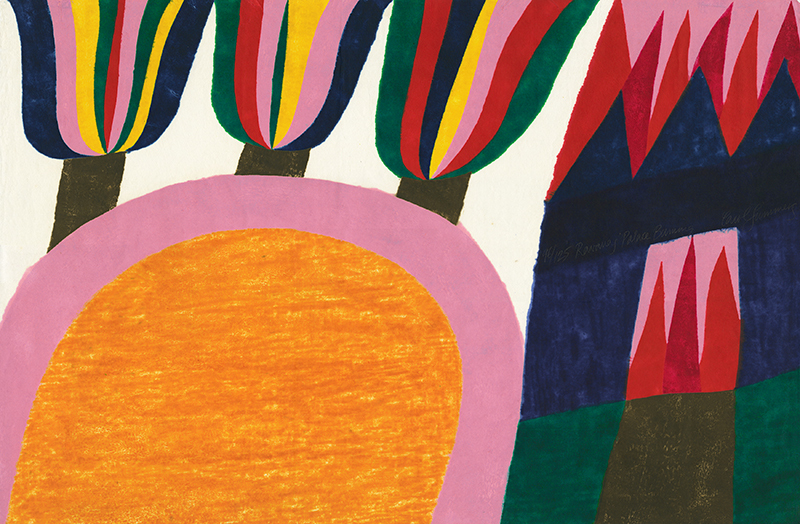
19th, 20th & 21st Century Fine Prints
707-546-7352 · fax 707-546-7924 · web: www.annexgalleries.com · email: artannex@aol.com
Ravana's Palace Burning by Carol Summers

Ravana's Palace Burning
Carol Summers
Ravana's Palace Burning
Carol Summers
1925 - 2016 (biography)Ravana is a ten-headed demon god of Hindu mythology, king of the island of Lanka and a devout follower of Shiva. He kidnapped the wife of Prince Rama, Sita, and held her prisoner in a garden in his palace on the island of Lanka. Rama would wage a battle against Ravana and Rama's companion, the god Hanuman, would burn down the palace, allowing Rama to slay the demon king and rescue Sita.
In his signature style, Carol Summers interprets this portion of the Hindu epic through a lens of vivid imagination: saturated color and large, exaggerated forms that soften as the inks are absorbed by the fibrous paper. The image is exultant and celebratory, a visual homage to triumph of good over evil.
Carol Summers was born on December 26, 1925 in Kingston, New York. His parents Ivan and Theresa Summers were both artists who had met in art school in St. Louis. During the Great Depression, when Carol was growing up, his father supported the family as a medical illustrator until he could return to painting. As well, he taught summers at Arizona State Teachers College where he instructed woodcut printmaking, which was the first time Carol was exposed to the medium. His mother was a watercolorist, and passed on her knowledge of the medium to Carol as well as her interest in paper and papermaking. Many years later, Summers would sometimes paint or print on thinly textured paper originally collected by his mother.
After a stint as a navigator bombardier in World War II, he returned to the states and under the G.I. Bill he trained in classical fine and studio arts at Bard College (1948-1951) studying painting with Steven Hirsh and printmaking with Louis Schanker, and in the summer of 1949 he studied at the Art Students League under Arnold Blanch. In 1954, he began teaching with a post at Haystack Mountain School of Crafts in Libery, Maine and the Brooklyn Museum School of Art.
Around this same time, along with fellow artist Leonard Baskin, Summers pioneered what is now referred to as the “monumental” woodcut. This term was coined in the early 1960s to denote woodcuts that were dramatically bigger than those previously created in earlier years, which were limited to the size of the matrices of small hand presses. Summers ultimately refined a relief printmaking process akin to stone rubbings, which would eventually be called the “Carol Summers Method” or the “ Carol Summers Technique.”
He delevoped this printing method in reaction to the rigidity of the Japanese method, in which the artist applies ink directly to sharply-carved blocks, allowing for little variation, before printing images in reverse, a result he found "disconcerting". Wanting less predictability and softer edges, he found a way to saturate the surface of the paper with ink - usually a mulberry laid - while still allowing for just enough control to keep the colors from running together. Before printing, he centered a dry sheet of paper over the top of the cut wood block or blocks, securing it with giant clips, then rolled the ink directly on the front of the sheet of paper while pressing down onto the dry wood - similar to a rubbing. After the ink was applied to the front of the paper, Summers sprayed it with mineral spirits which acted as a thinning agent. The absorptive fibers of the paper drew the thinned ink away from the surface, softening the shapes and diffusing and muting the colors. This produced a unique glow that is a hallmark of the Summers printmaking technique.
By following his own method, Summers avoided the mirror-reversed image of a conventional print, allowing him control over the precise amount of ink that he wanted on the paper. In the majority of his woodcuts he made the blocks slightly larger than the paper so the image and color would bleed off the edge. He worked indpendently, cutting, inking, and pulling the works himself. His woodcuts revealed a sensitivity to wood, especially its absorptive qualities and the subtleties of the grain, which he often incorporated into his works.
